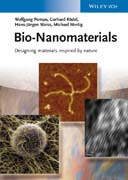
Bio-Nanomaterials: Designing Materials Inspired by Nature
Pompe, Wolfgang
Rödel, Gerhard
Weiss, Hans–Jürgen
Mertig, Michael
Bio–nanotechnology covers the development of novel techniques and materials by making use of the inspiration derived from biomolecular structures and processes. The progress in molecular biology and microbiology over the past 50 years has provided a solid basis for such development. Well characterized natural biomolecules as well as tailored recombinant proteins and tailored microorganisms obtained by genetic engineering provide a large toolbox for the implementation of biological structures in a technical environment. Biologically inspired materials engineering enables, for example, the preparation of living tissue for regenerative bone therapy and the biologically controlled mineralization of precious metal catalysts via immobilized microorganisms. Written by authors from different fields to reflect the interdisciplinary nature of the topic, this book guides the reader through novel nano–materials processing inspired by nature. The presentation is structured around general principles in seven chapters, each composed of three parts: (1) biological case studies providing the motivation, (2) elucidation of the particular principle, (3) applications related to materials processing. INDICE: Preface IX 1 Molecular Units 1 1.1 Case Studies 1 1.1.1 Nucleic Acids 4 1.1.2 Proteins 11 1.1.3 Carbohydrates 20 1.1.4 Lipids 25 1.2 Basic Principles 27 1.2.1 The Persistence Lengths of Biopolymer Chains 27 1.2.2 Equilibrium Shape of a Semiflexible Polymer Chain 30 1.2.3 The Load–Extension Diagram of a Semiflexible Polymer Chain 31 1.2.4 Cooperativity 37 1.2.5 Protein Folding 39 1.2.6 DNA Melting Transition 46 1.2.7 Biocatalytic Reactions 46 1.3 Bioengineering 51 1.3.1 Biointerfacing 51 1.3.2 DNA–Based Nanotechnology 54 1.3.2.1 Biomolecular Templates for Submicrometer Electronic Circuitries 54 1.3.2.2 DNA–Based Nanoprobes 85 1.3.3 Protein–Based Nanotechnology 97 References 104 2 Molecular Recognition 109 2.1 Case Study 109 2.2 Basic Principles 112 2.2.1 Complementary Interaction between Proteins and Ligands 113 2.2.2 Cooperative Protein–Ligand Interaction 114 2.2.3 The Enzyme–Linked Immunosorbent Assay 116 2.3 Engineering of Biomolecular Recognition Systems 119 2.3.1 Engineering of Protein–Based Bioaffine Materials 119 2.3.1.1 Interfacing Mechanisms of Proteins via Bioaffinity 119 2.3.2 Engineering of Sensing Biofunctionalized Materials 127 2.3.2.1 Design Principles of Biosensors 128 2.3.2.2 Integration of Sensing Biological Elements and Transducer Units 129 References 147 3 Cell Adhesion 149 3.1 Case Study 150 3.2 Basic Principles 154 3.2.1 The Cellular Mechanotransduction System 154 3.2.2 Mechanical Impact of the ECM on Cell Development 158 3.2.3 Influence of the Microenvironment Topology on the Cell Spreading and Development 162 3.3 Bioengineering 164 3.3.1 The Basic Approach and Goals 164 3.3.2 Tailored Surfaces for In Vitro Culturing of Cells 168 3.3.2.1 A Modular Polymer Platform for Mechanically Regulated Cell Culturing at Interfaces 168 3.3.2.2 Regulation of Cell Fate by Nanostructured Surfaces 172 3.3.3 Three–Dimensional Scaffolds for Tissue Engineering 175 3.3.4 Switchable Substrates and Matrices 176 References 181 4 Whole–Cell Sensor Structures 183 4.1 Case Studies 183 4.2 Basic Principles 184 4.3 Bioengineering 187 References 197 5 Biohybrid Silica–Based Materials 199 5.1 Case Studies 199 5.2 Basic Principles 205 5.2.1 Preparation of Silica–Based Xerogels 205 5.2.2 Biological Properties of Silica–Based Biocers 212 5.3 Bioengineering 215 5.3.1 Bioactive Sol–Gel Coatings and Composites 216 5.3.2 Biocatalytic Sol–Gel Coatings 221 5.3.3 Bioremediation 223 5.3.4 Cell–Based Bioreactors 228 5.3.5 Silica–Based Controlled Release Structures 229 5.3.6 Patterned Structures 230 5.4 Silicified Geological Biomaterials 231 References 234 6 Biomineralization 237 6.1 Case Studies 237 6.2 Basic Principles 240 6.2.1 Precipitation 244 6.2.1.1 Thermodynamics of Mineralization 245 6.2.1.2 Kinetics of Mineralization 250 6.2.2 Phenomenology of Biomineralization 253 6.2.3 Basic Mechanisms in Biomineralization 254 6.2.4 Biologically Mediated Mineralization: the Competition between Inhibition and Growth 255 6.2.4.1 Effect of Polypeptides on Precipitate Habitus 256 6.2.4.2 The Formation of Metastable Polymorphs 258 6.2.5 Biologically Induced Mineralization: Role of the Epicellular Space and the Extracellular Polymeric Substances 260 6.2.6 Biologically Controlled Mineralization: Molecular Preorganization, Recognition, and Vectorial Growth 267 6.2.6.1 Intracellular Mineralization 267 6.2.6.2 Epi– and Extracellular Mineralization 272 6.2.7 Mineralization of Diatom Shells: an Example of Unicellular Hierarchical Structures 277 6.2.8 Mineralization of Bone: an Example of Multicellular Biomineralization 282 6.2.8.1 The Mesoscopic Architecture of Bone 284 6.2.8.2 Bone Remodeling and Bone Repair 287 6.2.8.3 The Nanoscopic Structure of the Extracelluar Matrix of Bone 292 6.2.8.4 The Polymer–Induced Liquid Precursor Process 298 6.2.8.5 Scale–Dependent Mechanical Behavior of Bone 301 6.2.9 Ancient Evidence of Biomineralization 304 6.2.9.1 Stromatolites: the Oldest Fossils by Biogenic Mineralization 304 6.3 Bioengineering 306 6.3.1 Bacteria–Derived Materials Development 306 6.3.1.1 Bio–Palladium: Biologically Controlled Growth of Metallic Nanoparticles 306 6.3.1.2 Biogenic Ion Exchange Materials 313 6.3.2 Bio–Inspired Design of Mineralized Collagen and Bone–Like Materials 314 6.3.2.1 Biomimetic Growth of Apatite–Gelatin Nanocomposites 314 6.3.2.2 Biomimetic Manufacturing of Mineralized Collagen Scaffolds 324 6.3.3 Biomimicking of Bone Tissue 338 6.3.3.1 Natural versus Synthetic Biopolymers for Scaffold Design 339 6.3.3.2 Protein–Engineered Synthetic Polymers 341 6.3.3.3 Protein–Engineered Collagen Matrices 345 6.3.4 Microbial Carbonate Precipitation in Construction Materials 354 6.3.5 The Potential of Biomineralization for Carbon Capture and Storage (CCS) 357 References 359 7 Self–Assembly 367 7.1 Case Study 367 7.2 Basic Principles 372 7.2.1 Basic Phenomena of Self–Assembly and Self–Organization 372 7.2.2 Self–Assembly of Protein Filaments: the Cytoskeleton 373 7.2.3 Self–Assembly of b–Sheets: the Amyloid Fibrils 380 7.2.4 Self–Assembly of Two–Dimensional Protein Lattices: the Bacterial Surface Layers (S–Layers) 381 7.2.5 Self–Organized Structures of Lipids 392 7.2.6 Liquid Crystals 396 7.3 Bioengineering 398 7.3.1 In Vitro Self–Assembly of Large–Scale Nanostructured Biomaterials 399 7.3.2 Template–Directed Assembly of Artificial Nanoparticles and Nanowires 413 7.3.3 Template–Free Directed Self–Assembly of Nanoparticles 429 References 437 Appendix A Constants, Units, and Magnitudes 441 A.1 Fundamental Constants 441 A.2 Table of SI Base Units 441 A.3 Table of Derived Units 442 A.4 Magnitudes 442 A.4.1 Sizes 442 A.4.2 Energies 443 A.4.3 Rates and Diffusion Constants 443 Appendix B Energy of a Bent Fiber 445 Appendix C Circular Dichroism Spectroscopy 447 Appendix D Task Solutions 449 Index 453
- ISBN: 978-3-527-41015-6
- Editorial: Wiley VCH
- Encuadernacion: Cartoné
- Páginas: 470
- Fecha Publicación: 03/07/2013
- Nº Volúmenes: 1
- Idioma: Inglés
